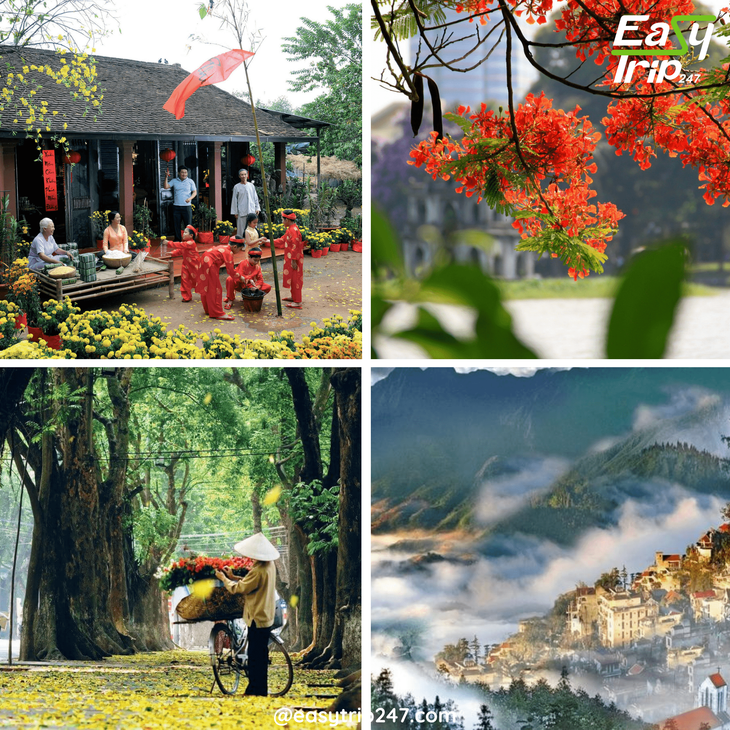What is the Weather Like in Vietnam Throughout the Year?
On
23/06/2025Reading time:
1 min
Summary:
Vietnam, a country known for its stunning landscapes, rich culture, and vibrant history, experiences a range of climates due to its unique geography. Stretching from the north to the south, Vietnam offers travelers a variety of weather conditions depending on when and where they visit.

The Four Distinct Seasons in Vietnam
Vietnam’s weather can be divided into four distinct seasons: spring, summer, autumn, and winter. Each season has its own charm and unique qualities, making it crucial to choose the ideal time to visit Vietnam based on your travel preferences.
Spring (February to April)
Spring in Vietnam is one of the best times to visit the country, especially in the northern and central regions. During this period, the weather is cool, pleasant, and dry, making it ideal for outdoor activities and sightseeing. In the north, the temperature ranges from 15°C to 22°C, with cool breezes that make it comfortable for trekking, visiting historical sites, or exploring the picturesque landscapes of places like Hanoi, Sapa, and Ha Long Bay.
Spring is also a great time to witness Vietnam’s famous Lunar New Year celebrations, or Tết, which usually takes place in late January or February. The holiday festivities bring the streets to life with parades, vibrant colors, and cultural performances. If you're wondering when the ideal time to visit Vietnam for such cultural experiences is, spring provides the perfect window for this.
In central Vietnam, cities like Hue and Da Nang enjoy moderate temperatures, ranging from 20°C to 28°C, with little rainfall. This makes it a fantastic time to explore ancient temples, beaches, and nature reserves without the scorching heat of summer. Similarly, the central coastal region remains pleasant and not too humid during spring, which contributes to it being the ideal time to visit Vietnam for beach lovers.
Summer (May to August)
Summer in Vietnam is characterized by hot, humid conditions, with higher temperatures and more rain, especially in the southern and central parts of the country. In the north, temperatures can soar to around 30°C, but the region still enjoys a bit of a respite from heavy rainfall. However, in the southern areas, such as Ho Chi Minh City and the Mekong Delta, temperatures during summer can reach upwards of 35°C. The humidity levels also increase, making it feel hotter.
For travelers who are looking for the ideal time to visit Vietnam for summer activities, the southern beaches are perfect during this time. The southern coast, including places like Phu Quoc and Vung Tau, experiences a more consistent climate throughout the year. The tropical rains tend to come in short bursts, and even though the weather is warm, it’s still great for enjoying water sports, lounging on the beach, or exploring the stunning islands.
While it’s the summer season in most parts of the country, it’s also the rainy season in the central and southern regions. Central Vietnam, including Da Nang and Hoi An, experiences heavier rainfall, particularly in the month of August. The tropical storms can sometimes disrupt travel plans, but these are usually brief and can be an exciting part of the experience for those who don't mind getting a little wet. If you want to avoid the wet season, consider visiting the northern regions like Hanoi and Ha Long Bay, where the climate remains more manageable.
In summary, summer is the ideal time to visit Vietnam if you want to experience the vibrant southern coast or enjoy beach holidays in central Vietnam. However, be prepared for higher humidity and potential rainfall, especially if traveling to the central and southern parts of the country.
Autumn (September to November)
Autumn is considered one of the best times to visit Vietnam due to its moderate weather, reduced rainfall, and beautiful natural scenery. In the north, autumn offers cool temperatures ranging from 20°C to 28°C, making it the ideal time to visit Vietnam for trekking, sightseeing, and exploring Vietnam’s cultural sites. The weather is perfect for outdoor activities, with less rain and comfortable humidity levels. Sapa’s terraced rice fields are particularly beautiful during this time, as they are ripe and golden, making autumn the perfect season for those looking to take stunning photos and enjoy the fresh mountain air.
In central Vietnam, autumn brings pleasant temperatures and lower humidity, with average temperatures ranging from 24°C to 30°C. This is a great time for visiting beaches, as the weather is warm but not overwhelmingly hot. Central Vietnam also enjoys fewer chances of rain during this time, making it a reliable option for travelers hoping to explore places like Hoi An and Hue without the threat of rain.
The southern region of Vietnam is also relatively dry during the autumn months, with temperatures between 25°C and 32°C. However, the rainy season starts to wind down, offering visitors a more comfortable climate for sightseeing and exploration. For those seeking to visit the Mekong Delta or southern islands like Phu Quoc, autumn provides the ideal time to visit Vietnam with less humidity and fewer storms.
Winter (December to January)
Winter in Vietnam can be quite different depending on the region you are visiting. In the northern regions, such as Hanoi and Sapa, the weather can be chilly, with temperatures ranging from 10°C to 18°C. This is an excellent time to explore northern Vietnam, as the weather is cool and crisp, but it’s not too cold for outdoor activities. Winter is also the ideal time to visit Vietnam for those who enjoy the quieter season, as tourist crowds tend to thin out during this time, providing a more serene experience.
The central coast of Vietnam, including Da Nang and Nha Trang, enjoys mild temperatures ranging from 20°C to 26°C. Winter is also an excellent time to visit the beaches in this region, as the weather is cooler but still comfortable for water activities, especially for those who wish to avoid the intense heat of summer. In the south, the weather is warm and dry, with temperatures ranging from 25°C to 30°C, which makes it an ideal time for beach vacations or city tours.
Vietnam’s winter months coincide with some of the country’s most festive celebrations, including Christmas and the Vietnamese Lunar New Year (Tết), making it a fantastic time to visit if you want to experience the country's lively cultural festivities. Cities are adorned with festive lights, and many tourist sites host celebrations, making winter a great time for travelers looking for a blend of great weather and cultural experiences.
Choosing the Ideal Time to Visit Vietnam
When planning a trip to Vietnam, the ideal time to visit Vietnam will depend on what you want to experience. Spring (February to April) and autumn (September to November) offer mild, comfortable weather across the country, making them popular times for tourists. However, if you’re looking to explore the southern beaches or enjoy the vibrant life of the cities, summer (May to August) may suit your travel plans better. Winter (December to January) offers cool weather in the north and warm temperatures in the south, along with festive cultural events.
In conclusion, Vietnam’s diverse climate makes it possible to enjoy the country year-round, but understanding the weather in different regions will help you pick the ideal time to visit Vietnam based on your specific travel goals. Whether you're hiking in the north, enjoying the beaches in the south, or exploring the central region’s ancient sites, there’s a perfect time to experience everything this beautiful country has to offer.
Design Your Tour Today And Get A Quote. Contact Us Here: +84.975.504.825
Source: Easytrip247 Team compiled.
